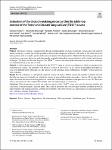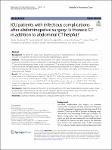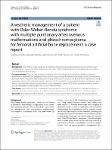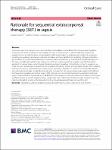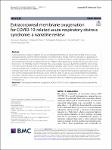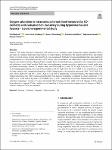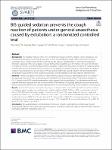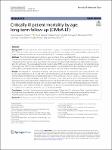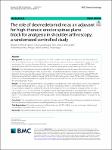Search
Author
- Osman, Ahmed I. (5)
- Daqing, Ma (3)
- Jorgensen, Ed (3)
- Li, Yan (3)
- next >
Subject
- kinh tế (26)
- Economics (12)
- programming (10)
- XRD (10)
- next >
Date issued
- 2020 - 2025 (2129)
- 2010 - 2019 (129)
- 2000 - 2009 (9)
- 1999 - 1999 (1)
Has File(s)
Search Results
The threat of terror is omnipresent in Europe and the number of attacks worldwide is increasing. The target of attacks in Europe is usually the civilian population. Incalculable dangerous situations at the scene of the event and severe injury patterns such as complex gunshot and explosion injuries with a high number of highly life-threatening people present rescue forces, emergency physicians and subsequently hospitals with medical, organizational as well as tactical and strategic challenges. The Terror and Disaster Surgical Care (TDSC®) course trains clinical decision-makers to meet these challenges of a TerrorMASCAL in the first 24–48 h. |
The aim of this study was to assess the usefulness of adding thoracic CT to abdominal CT in intensive care unit (ICU) patients with signs of infection after abdominopelvic surgery. |
Osler-Weber-Rendu syndrome is characterized by mucocutaneous telangiectasia and arteriovenous malformations in organs. Anesthesia for patients with Osler-Weber-Rendu syndrome is challenging due to complications and physiological changes. |
Sepsis and septic shock remain drivers for morbidity and mortality in critical illness. The clinical picture of patients presenting with these syndromes evolves rapidly and may be characterised by: (a) microbial host invasion, (b) establishment of an infection focus, (c) opsonisation of bacterial products (e.g. lipopolysaccharide), (d) recognition of pathogens resulting in an immune response, (e) cellular and humoral effects of circulating pathogen and pathogen products, (f) immunodysregulation and endocrine effects of cytokines, (g) endothelial and organ damage, and (h) organ crosstalk and multiple organ dysfunction. Each step may be a potential target for a specific therapeutic approach. |
A growing body of evidence supports the use of extracorporeal membrane oxygenation (ECMO) for severe acute respiratory distress syndrome (ARDS) refractory to maximal medical therapy. ARDS may develop in a proportion of patients hospitalized for coronavirus disease 2019 (COVID-19) and ECMO may be used to manage patients refractory to maximal medical therapy to mitigate the risk of ventilator-induced lung injury and provide lung rest while awaiting recovery. The mortality of COVID-19-related ARDS was variously reassessed during the pandemic. |
Purpose: This study intended to determine, and non-invasively evaluate, sternal intraosseous oxygen saturation (SsO2) and study its variation during provoked hypoxia or hypovolaemia. Furthermore, the relation between SsO2 and arterial (SaO2) or mixed venous oxygen saturation (SvO2) was investigated. Methods: Sixteen anaesthetised male pigs underwent exsanguination to a mean arterial pressure of 50 mmHg. After resuscitation and stabilisation, hypoxia was induced with hypoxic gas mixtures (air/N2). |
The multiple modes of SARS-CoV-2 transmission including airborne, droplet, contact and faecal–oral transmissions that cause coronavirus disease 2019 (COVID-19) contribute to a public threat to the lives of people worldwide. Heavy aerosol production by coughing and the big peak expiratory flow in patients with respiratory infections (especially SARS-CoV-2) during recovery from general anaesthesia are the highest risk factors for infection in healthcare workers. To perform sedation before extubation significantly reduced the incidence of coughing during recovery from general anaesthesia. However, there are few studies on endotracheal tube removal under BIS-guided sedation in postanaesthesia care unit (PACU). |
The past years have witnessed dramatic changes in the population admitted to the intensive care unit (ICU). Older and sicker patients are now commonly treated in this setting due to the newly available sophisticated life support. However, the short- and long-term benefit of this strategy is scarcely studied. |
Data on the epidemiology, treatment, and outcome of burn patients treated at non-burn centre hospitals are not available. The primary aim was to compare the burn characteristics of patients admitted to a hospital with or without a specialized burn centre. |
Management of postoperative pain after shoulder arthroscopy is an important issue. Dexmedetomidine, as an adjuvant, improves nerve block efficacy and decreases postoperative consumption of opioids. As a result, we designed this study to determine if adding dexmedetomidine to an erector spinae plane block (ESPB) that is guided by ultrasound (US) is beneficial for treating immediate postoperative pain following shoulder arthroscopy. |

